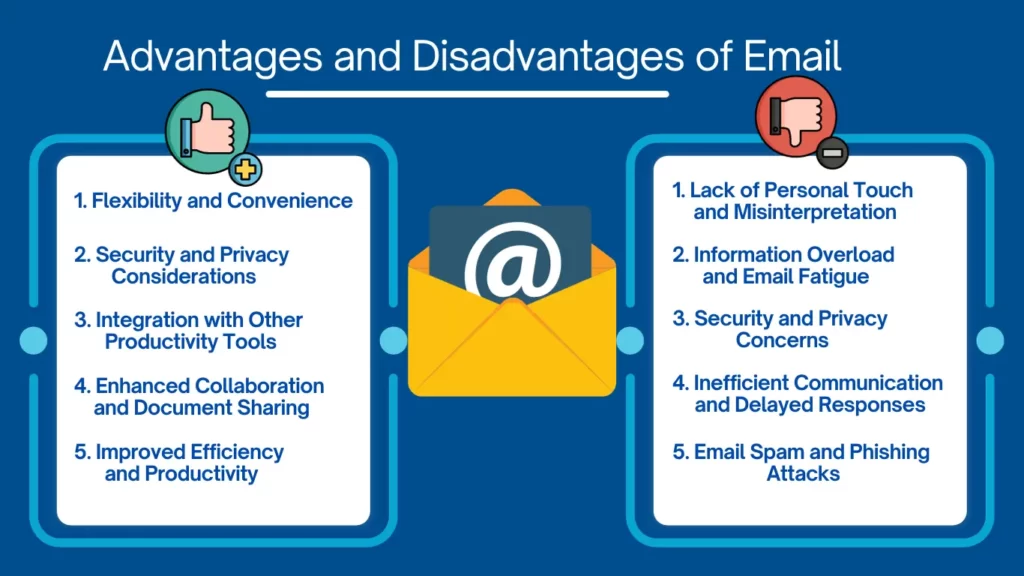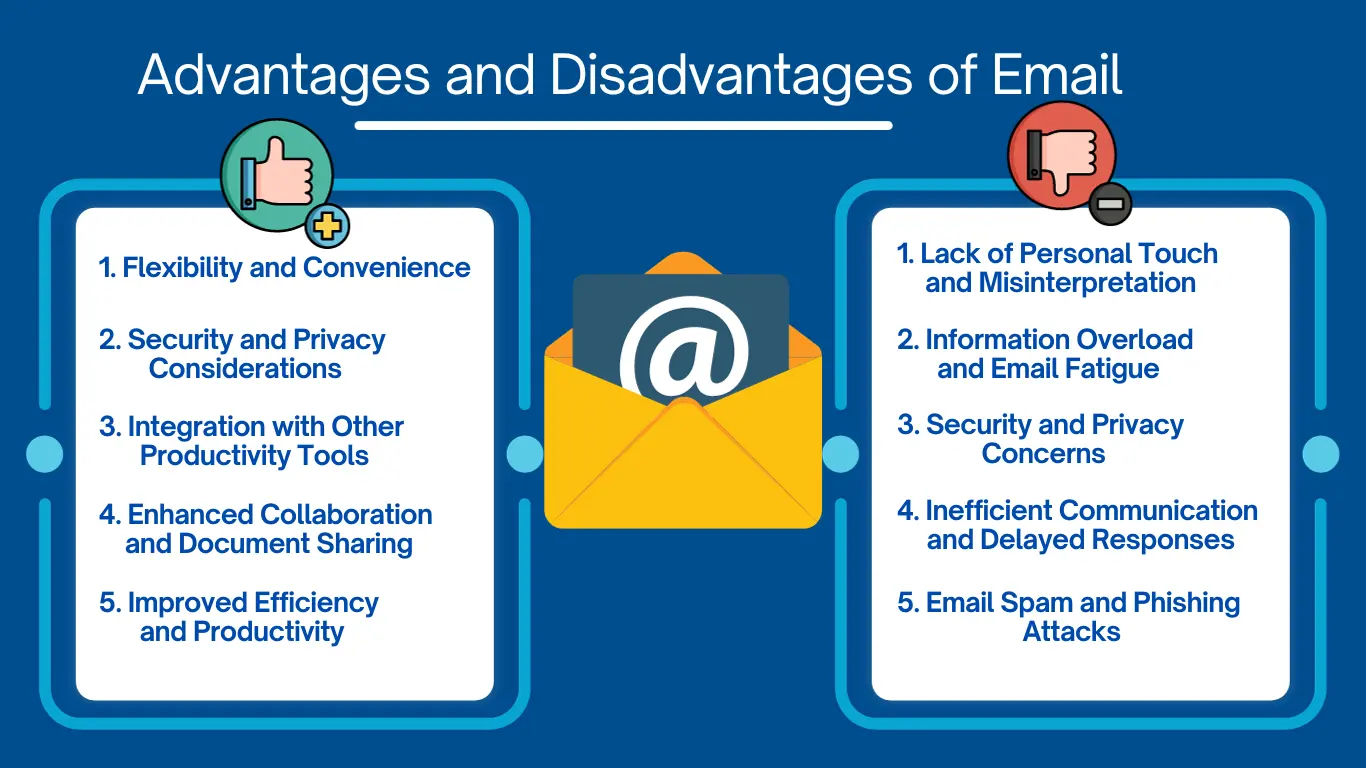Advantages and Disadvantages of Email: Email has become an indispensable tool in the modern workplace, and for good reason. Its flexibility, convenience, and ease of use have made it a go-to method of communication for businesses of all sizes.

But email is more than just a way to send messages back and forth. It can actually have a significant impact on productivity and efficiency in the workplace. In this article, we’ll explore the Advantages and Disadvantages of Email.
Advantages and Disadvantages of Email| E-mail Advantages and Disadvantages
Advantages of Email
1. Flexibility and Convenience
One of the biggest advantages of email is its flexibility and convenience. Unlike phone calls or face-to-face meetings, email allows you to send and receive messages at any time, from anywhere. With email, you can quickly respond to messages, even when you’re out of the office, and keep the lines of communication open with your colleagues and clients.
Another advantage of email is the ability to send and receive attachments. This is particularly useful when you need to share documents or other important files with your team members. Instead of having to print out hard copies or send files via a flash drive, you can simply attach them to an email and send them on their way.
2. Security and Privacy Considerations
Email is not always a secure method of communication, and messages can be intercepted or hacked if proper precautions are not taken. This is especially true when sending sensitive information, such as financial data or personal information.
To ensure the security of your emails, it’s important to use a secure email service that uses encryption to protect your messages. You should also avoid sending sensitive information via email whenever possible, and consider using a secure file-sharing service instead. It’s also a good idea to avoid using your work email for personal purposes, as this can blur the lines between your personal and professional life.

3. Integration with Other Productivity Tools
Email is not just a standalone tool, but can be integrated with other productivity tools to enhance efficiency and collaboration in the workplace. For example, many email services offer calendar integration, allowing you to schedule meetings and appointments directly from your email client. This saves time and ensures that everyone is on the same page when it comes to scheduling.
Email can be integrated with customer relationship management (CRM) tools to streamline communication with clients and customers. Emails can be automatically logged into the CRM system, allowing you to keep track of all communication with clients and ensure that you’re providing the best possible service.
4. Enhanced Collaboration and Document Sharing
With email, team members can share documents and work on projects together, no matter where they are located. This is especially useful for remote teams or teams that are spread out across different locations.
Email allows for real-time collaboration and feedback. Team members can send drafts of documents or proposals via email, and receive feedback and comments from other team members in real time. This saves time and ensures that everyone is on the same page when it comes to completing projects.
5. Improved Efficiency and Productivity
By streamlining communication and collaboration, email can help teams work more efficiently and get more done in less time. This can lead to cost savings, increased revenue, and a better overall work environment.
Email allows for quick and easy communication with clients and customers. This can help businesses respond more quickly to customer needs and provide better service. By using email to communicate with clients and customers, businesses can build stronger relationships and improve customer satisfaction.
Email can help businesses reduce their environmental footprint by reducing paper waste. Instead of printing out hard copies of documents or sending faxes, businesses can use email to send and receive documents electronically.
Disadvantages of Email

1. Lack of Personal Touch and Misinterpretation
One of the major disadvantages of email communication is the lack of personal touch. Unlike face-to-face or phone conversations, email lacks the nuances of body language, facial expressions, and tone of voice. This absence of non-verbal cues can often lead to misinterpretation of messages, causing misunderstandings and conflicts.
Without the ability to see or hear the sender, it becomes challenging to gauge the emotions or intentions behind their words. A simple statement like “I appreciate your efforts” can be interpreted differently depending on the recipient’s mood or perception. This ambiguity can lead to misunderstandings and strain professional relationships.
2. Information Overload and Email Fatigue
In today’s fast-paced work environment, we are bombarded with countless emails on a daily basis. The constant influx of messages can quickly become overwhelming, leading to information overload and email fatigue. The need to constantly check and respond to emails can be mentally exhausting, leaving little time and energy for other important tasks.
To combat information overload and email fatigue, it is essential to establish effective email management strategies. This includes setting aside dedicated time slots for checking and responding to emails, utilizing filters and folders to organize incoming messages, and adopting a concise and focused writing style to ensure clear communication.
3. Security and Privacy Concerns
Email communication poses inherent security and privacy concerns, making it susceptible to unauthorized access and data breaches. Despite the advancements in encryption and security measures, email systems remain vulnerable to hacking and phishing attacks.
To mitigate security and privacy risks, it is crucial to adopt best practices when it comes to email communication. This includes using strong and unique passwords, avoiding clicking on suspicious links or downloading attachments from unknown sources, and utilizing encryption tools when sharing sensitive information.
4. Inefficient Communication and Delayed Responses
Despite its convenience, email communication can sometimes be inefficient, leading to delayed responses and prolonged decision-making processes. The asynchronous nature of email communication means that responses may not be immediate, especially when dealing with individuals in different time zones or with busy schedules.
To overcome these challenges, it is crucial to establish clear expectations regarding response times and prioritize urgent matters. Utilizing other communication channels, such as instant messaging or video conferencing, for time-sensitive discussions can also help facilitate efficient communication and reduce delays.
5. Email Spam and Phishing Attacks
One of the most prevalent issues in email communication is the onslaught of spam messages and phishing attacks. Spam emails, which consist of unsolicited advertisements or fraudulent schemes, not only clutter our inboxes but also pose a security risk.
To protect oneself from email spam and phishing attacks, it is essential to be vigilant and exercise caution when interacting with unknown or suspicious emails. Avoid clicking on suspicious links or downloading attachments without proper verification.
So that’s all about the Advantages and Disadvantages of Email.

